Deep within the vibrant forests of the Americas, a creature of boundless curiosity and distinctive charm roams. With its long, flexible snout constantly twitching, its ringed tail held high, and an insatiable appetite for discovery, the Coati is a true marvel of the animal kingdom. Often mistaken for a ferret, a monkey, or even a raccoon, this fascinating mammal, a relative of the common raccoon, carves out a unique niche, captivating all who encounter its lively antics.
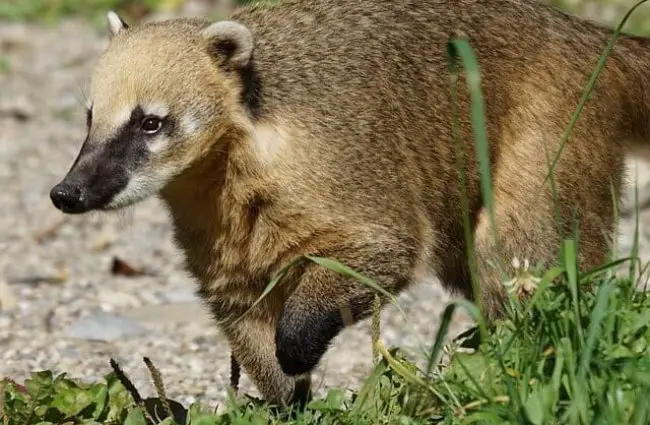
Meet the Coati: A Forest Dweller’s Profile
Coatis, pronounced “koh-AH-tee,” are medium-sized mammals belonging to the family Procyonidae, which also includes raccoons, kinkajous, and olingos. There are four recognized species: the White-nosed Coati (Nasua narica), the South American Coati (Nasua nasua), Nelson’s Coati (Nasua nelsoni), and the Mountain Coati (Nasuella olivacea). Each species possesses the characteristic elongated, mobile snout and a long, often ringed tail that can be as long as its body.
- Size: Coatis typically measure between 13 to 27 inches (33 to 69 cm) from head to rump, with their tails adding another 13 to 27 inches (33 to 69 cm). They weigh between 4 to 18 pounds (2 to 8 kg).
- Appearance: Their fur color varies from reddish-brown to dark brown or gray, often with lighter underparts. Their faces usually feature lighter markings around the eyes and snout, creating a masked appearance. The tail, often banded with darker rings, is not prehensile but is crucial for balance, especially when climbing.
- Lifespan: In the wild, Coatis can live for 7 to 8 years, while in captivity, they may reach up to 15 years.
Where Coatis Call Home: Habitat and Distribution
Coatis are exclusively found in the Americas, ranging from the southwestern United States, through Mexico and Central America, and deep into South America. Their preferred habitats are diverse, showcasing their adaptability:
- Forests: They thrive in tropical and subtropical forests, including rainforests, deciduous forests, and cloud forests.
- Woodlands: Open woodlands and gallery forests along rivers are also common haunts.
- Mountainous Regions: The Mountain Coati, as its name suggests, inhabits higher elevations, often in cooler, more rugged terrain.
Their presence is a good indicator of a healthy forest ecosystem, as they require a rich environment for foraging and shelter.
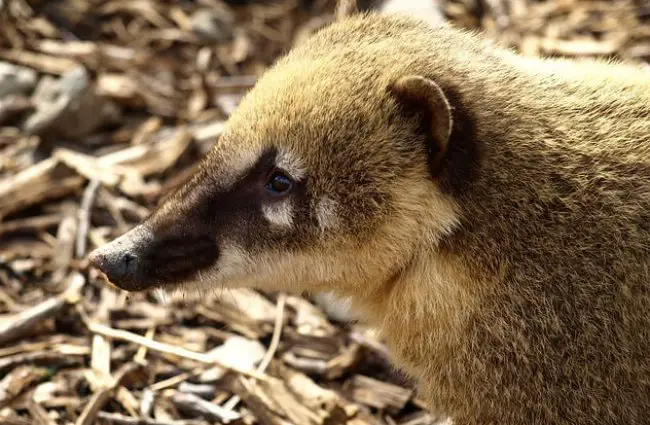
The Coati’s Menu: An Omnivore’s Delight
Coatis are classic omnivores, with a diet that shifts seasonally and geographically. Their long, flexible snout is perfectly adapted for rooting through leaf litter and crevices, sniffing out hidden meals.
- Insects and Invertebrates: A significant portion of their diet consists of beetles, grubs, spiders, scorpions, ants, and termites. They are adept at digging these out from under rocks and logs.
- Fruits: They consume a wide variety of fruits, berries, and nuts, playing a vital role in seed dispersal.
- Small Vertebrates: Occasionally, they will prey on small lizards, rodents, birds, and bird eggs.
This varied diet highlights their opportunistic nature and their ability to exploit different food sources throughout the year.
Social Circles: Bands and Solitary Wanderers
One of the most distinctive aspects of Coati behavior is their social structure, which varies significantly between sexes:
- Female Bands: Adult females and their offspring live in social groups called “bands” or “troops,” which can number from 4 to 30 individuals. These bands forage together, groom each other, and cooperatively raise the young. This communal living offers protection against predators and aids in finding food.
- Solitary Males: Adult males, in contrast, are largely solitary. They are often seen roaming alone, only joining female bands during the breeding season. This solitary existence helps reduce competition for resources within the female groups and may also be a strategy to avoid infanticide by other males.
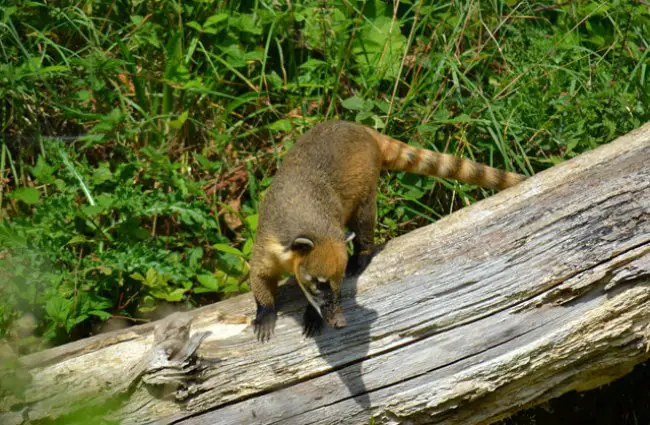
Delving Deeper: Coati Biology and Ecology
Evolutionary Journey: A Branch of the Raccoon Family
The evolutionary history of Coatis places them firmly within the Procyonidae family, a group of small to medium-sized New World carnivores. Their closest relatives include raccoons (genus Procyon), kinkajous (genus Potos), and ringtails (genus Bassariscus). Fossil evidence suggests that the Procyonidae family originated in North America and later diversified, with Coati ancestors migrating south into Central and South America. Their unique elongated snout is a specialized adaptation for their foraging strategy, distinguishing them from their more generalized raccoon cousins.
- Shared Traits: Like raccoons, Coatis possess a high degree of manual dexterity and an omnivorous diet.
- Divergent Paths: The development of their highly mobile snout and their distinct social structure are key evolutionary divergences.
The Cycle of Life: Mating and Reproduction
Coati reproduction is a fascinating seasonal event, typically occurring once a year, often coinciding with the abundance of fruit. The solitary males will temporarily join female bands during this period.
- Courtship: Males approach female bands cautiously, often facing initial aggression from the females. They may engage in elaborate displays to gain acceptance.
- Gestation: After successful mating, the gestation period lasts approximately 77 days.
- Denning: Pregnant females leave their bands shortly before giving birth to construct a solitary nest, or “den,” usually in a tree hollow, rock crevice, or abandoned burrow. This isolation protects the vulnerable newborns from potential threats within the band, including infanticide by other Coatis.
- Birthing: A litter typically consists of 2 to 6 altricial (helpless) young, born blind and sparsely furred.
- Parental Care: The mother diligently cares for her young in the den for several weeks, nursing them and protecting them.
- Rejoining the Band: Once the young are strong enough, usually around 5 to 6 weeks old, the mother and her offspring rejoin the female band. The young then benefit from the communal protection and learning opportunities offered by the group.
- Sexual Maturity: Coatis reach sexual maturity around 2 years of age.
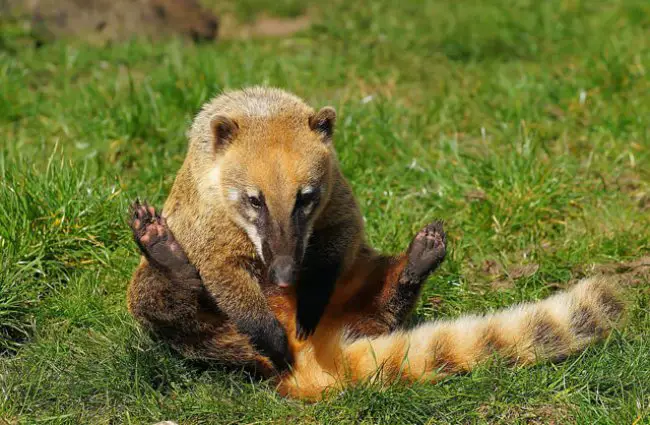
Ecosystem Engineers: Coatis’ Role and Interactions
Coatis are integral components of their ecosystems, playing multiple roles that contribute to forest health and biodiversity.
- Seed Dispersal: By consuming a wide variety of fruits and then dispersing the seeds through their droppings, Coatis act as crucial seed dispersers, aiding in forest regeneration and plant diversity.
- Pest Control: Their voracious appetite for insects and other invertebrates helps control populations of potential agricultural pests and forest insects.
- Prey Species: Coatis themselves are a food source for larger predators, including jaguars, pumas, ocelots, boa constrictors, and large raptors. Their vigilance and group living (for females) are adaptations to minimize predation risk.
- Interspecies Interactions: They often forage alongside other animals, such as peccaries, taking advantage of disturbed ground that exposes insects. They may also compete with other omnivores for food resources.
Coatis and Humanity: From Culture to Conservation
The relationship between Coatis and humans is multifaceted, ranging from cultural significance to practical interactions.
Cultural Footprint
In some indigenous cultures of Central and South America, Coatis appear in folklore and oral traditions, often depicted as clever, mischievous, or resourceful creatures. Their distinctive appearance and lively behavior make them memorable figures in local narratives.
Interactions in the Wild
Coatis are generally curious animals and, in areas with frequent human presence, can become habituated. This can lead to both positive and negative interactions:
- Observation: For nature enthusiasts and hikers, observing Coatis in their natural habitat is a rewarding experience. Their foraging behavior and social dynamics are captivating.
- Food Scavenging: Unfortunately, habituation can also lead Coatis to scavenge for human food in picnic areas, campsites, and even urban fringes. This can be detrimental to their health and lead to conflicts.
- What to Do if You Encounter a Coati:
- Observe from a Distance: Appreciate their beauty without disturbing them.
- Never Feed Them: Feeding wild animals disrupts their natural foraging behaviors and can make them dependent on human food, which is often unhealthy for them.
- Secure Food and Trash: If camping or picnicking in Coati territory, ensure all food is stored in animal-proof containers and trash is properly disposed of.
- Do Not Approach or Touch: While generally not aggressive, Coatis are wild animals and can bite or scratch if they feel threatened.
Coatis in Captivity: A Zookeeper’s Guide
Caring for Coatis in a zoological setting requires a deep understanding of their natural history and behavioral needs.
- Enclosure Design:
- Spacious and Vertical: Coatis are agile climbers, so enclosures must be large, with ample vertical space, climbing structures (branches, ropes), and elevated platforms.
- Substrate: A natural substrate like soil, leaf litter, or mulch allows for their natural digging and foraging behaviors.
- Shelter: Provide multiple den boxes or hollow logs for resting, sleeping, and privacy.
- Water: A clean water source for drinking and potentially a shallow pool for wading.
- Diet:
- Varied Omnivorous Diet: A balanced diet should include commercial omnivore chow, a wide variety of fresh fruits and vegetables, and a significant portion of insects (crickets, mealworms, roaches) or lean protein sources.
- Foraging Enrichment: Scatter food, hide it in puzzle feeders, or bury it in the substrate to encourage natural foraging behaviors.
- Social Needs:
- Female Groups: House females in social groups, mimicking their natural bands.
- Solitary Males: Adult males should generally be housed individually, except during controlled breeding periods.
- Introduction Protocols: Any new introductions must be carefully managed and monitored to ensure compatibility.
- Enrichment:
- Environmental Enrichment: Regularly change the layout of the enclosure, introduce new climbing structures, and provide novel scents.
- Behavioral Enrichment: Offer puzzle feeders, toys, and opportunities for digging and exploring.
- Sensory Enrichment: Provide different textures, smells, and sounds.
- Veterinary Care: Regular health checks, vaccinations, and parasite control are essential.
- Avoid:
- Small, Barren Enclosures: These lead to stress and stereotypical behaviors.
- Inappropriate Diet: Overfeeding sugary fruits or processed human foods.
- Forced Socialization: Attempting to house incompatible individuals or forcing solitary males into permanent groups.
- Lack of Enrichment: Leads to boredom and behavioral issues.
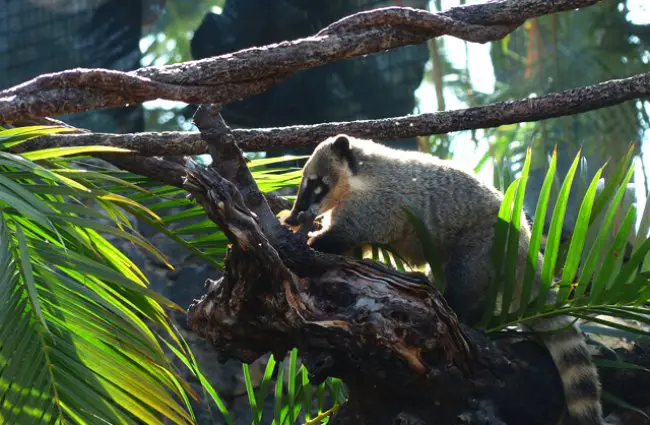
Fascinating Coati Facts
Here is a collection of intriguing facts about these charismatic creatures:
- Nose Knows Best: Their highly flexible snout can rotate up to 60 degrees in any direction, making them incredibly efficient at sniffing out food hidden underground or in crevices.
- Tail Tales: While not prehensile, the Coati’s long tail is used as a counterbalance when climbing trees and helps them communicate, often held upright as a signal to other Coatis.
- Arboreal Acrobats: Coatis are excellent climbers and spend a significant amount of time in trees, where they rest, sleep, and forage for fruits and insects. They can descend trees headfirst, a feat few other mammals can accomplish.
- Diurnal Diggers: Unlike many nocturnal forest dwellers, Coatis are primarily diurnal, meaning they are active during the day. This allows them to exploit different food sources and avoid competition with nocturnal predators.
- “Coati Mundi”: The name “Coati Mundi” is sometimes used, particularly for solitary males. “Coati” is derived from the Tupi language, meaning “long nose,” and “Mundi” means “alone.”
- Vocal Variety: Coatis communicate through a range of vocalizations, including chirps, snorts, grunts, and alarm calls, helping to keep their bands cohesive and alert to danger.
- Keen Senses: Beyond their incredible sense of smell, Coatis have excellent hearing and good eyesight, all contributing to their foraging success and predator avoidance.
- Adaptable Feet: Their strong claws are perfect for digging, and their ankles are flexible, allowing them to rotate their hind feet 180 degrees for better grip when descending trees.
Finding Coatis in the Wild: A Guide for Animal Lovers
For those hoping to spot a Coati, patience and knowledge of their habits are key.
- Where to Look: Focus on their known range in Central and South America, and parts of the southwestern U.S. Look for them in tropical and subtropical forests, especially near water sources.
- When to Look: Coatis are diurnal, so the best times for observation are during daylight hours, particularly in the early morning or late afternoon when they are most active.
- Signs of Presence: Look for disturbed leaf litter, small diggings in the soil, and droppings containing seeds or insect fragments. Their distinctive tracks may also be visible.
- Behavior to Observe: Watch for groups of females and young foraging together, rooting through the undergrowth with their snouts. Solitary males might be seen moving more cautiously.
- Respect Wildlife: Always maintain a respectful distance, avoid making loud noises, and never attempt to feed or interact with them. Binoculars are highly recommended for close-up views without disturbance.
The Enduring Appeal of the Coati
From their distinctive appearance and fascinating social structures to their vital role in maintaining healthy forest ecosystems, Coatis are truly captivating creatures. They embody the spirit of the wild, constantly exploring, adapting, and thriving in their diverse habitats. Understanding and appreciating these remarkable mammals not only enriches our knowledge of biodiversity but also underscores the importance of conserving the precious ecosystems they call home. The next time you hear a rustle in the undergrowth of an American forest, keep an eye out for that twitching snout and high-held tail; you might just be in the presence of a Coati, a true testament to nature’s ingenuity.

![Red Angus Closeup of a beautiful Red Angus cowPhoto by: U.S. Department of Agriculture [pubic domain]https://creativecommons.org/licenses/by/2.0/](https://animals.net/wp-content/uploads/2020/03/Red-Angus-4-238x178.jpg)




![Red Angus Closeup of a beautiful Red Angus cowPhoto by: U.S. Department of Agriculture [pubic domain]https://creativecommons.org/licenses/by/2.0/](https://animals.net/wp-content/uploads/2020/03/Red-Angus-4-100x75.jpg)

